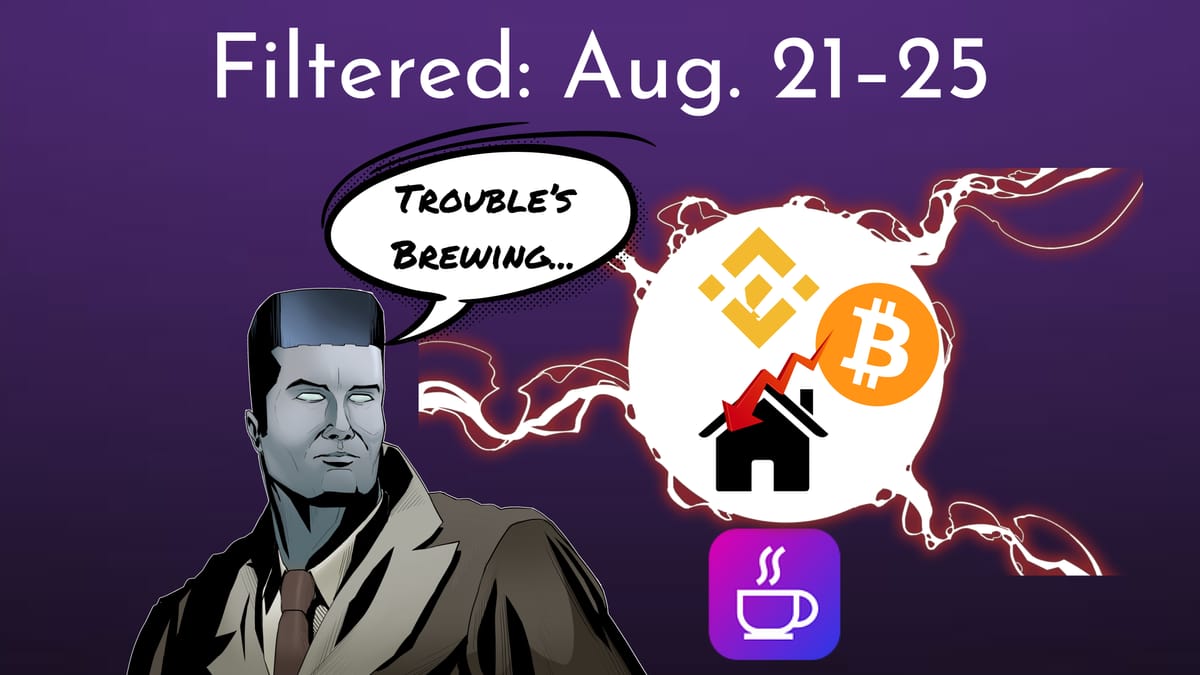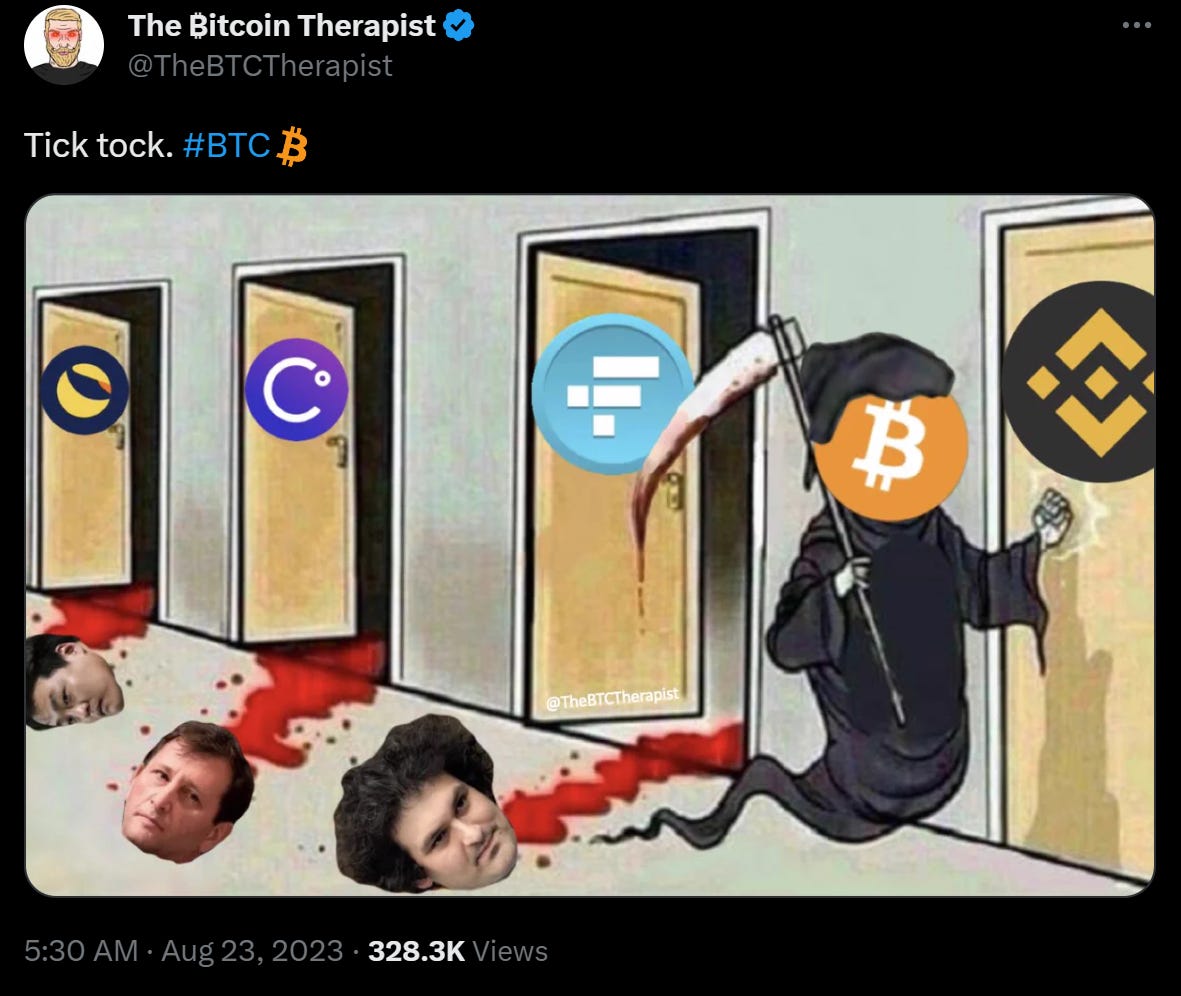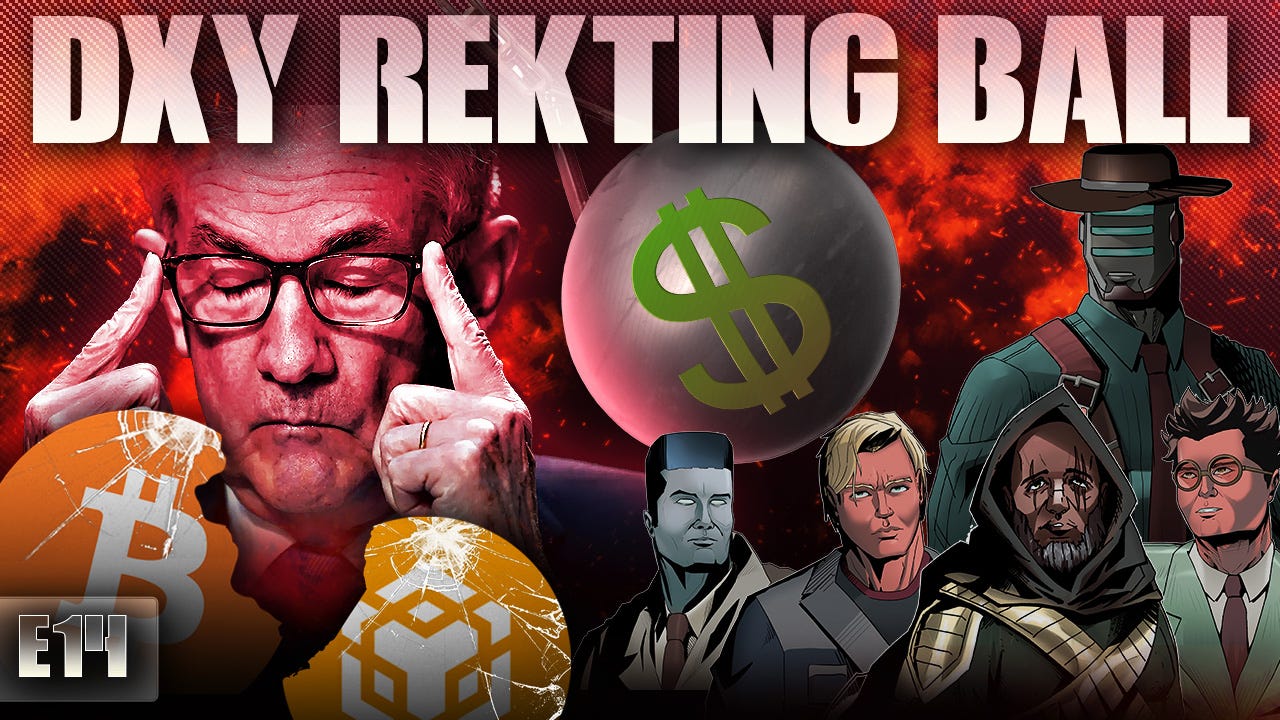From Bad to Worse to…?
Filtered: August 21 – 25

After what seemed like a never-ending period of ultra-low volatility, crypto finally broke out. Or broke down, to be more accurate.
Last week’s selloff saw Bitcoin (BTC) lose 12% of its market cap overnight. The crypto market overall sank by almost 8%. And the crash triggered liquidations of more than $1 billion in crypto futures and options contracts.
While the market’s recovered somewhat since then, it’s definitely left plenty of investors shaken.
I wish I could tell you that that downward slide was just a temporary reset, and that crypto’s future is looking bright for the rest of the year. But in my mind, it’s more important to give it to you straight than to sell you a bag of artificial hopium.
That’s not to say we can’t stage a surprise rally into the end of the year. But both onchain and macro indicators paint a less-than-rosy picture.
The question is, what could be the next big catalyst to stir up volatility again? That’s the mystery that our squad of analysts delved into this week.
In “The Economy’s Healthy Appearance Is Only Skin-Deep,” our own Tyler laid out three blind spots in the U.S. economy that are getting closer and closer to blowing up.
The one that hit closest to home for me was commercial real estate. Based on what Tyler says, soon enough China might not be the only country facing a real estate crisis. And the effects of a crash in this sector would ripple farther than you think:
Rising vacancies, lack of demand due to more remote workers, companies slashing operation costs, higher interest rates, higher financing costs, and a surplus of office buildings are making commercial real estate a very unattractive investment (except for multifamily housing).
We’re starting to hear news that building owners are selling their properties because the loan on the building is more than the value of the building itself.
These issues can have a deeper impact on the economy than just triggering another local or regional bank crisis. The less-discussed impact is how they negatively affect pension funds and insurance companies.
Because of the low interest rates of the past few years, pension funds and insurance companies couldn’t find enough high-quality liquid assets to invest in and match their long-term liabilities.
Investing in Treasuries that pay a meager 2% while you have to pay 7% to pensioners just does not work. So pension funds and insurance companies turned to other investment vehicles, such as commercial real estate trusts, to garner a higher yield and fulfill their financial obligations.
Should the commercial real estate market continue to falter, it could spell trouble for these entities.
In the rest of the essay, Tyler dives more into the state of commercial real estate along with two other ticking time bombs being overlooked by the financial media.
Meanwhile, the Xchanging Good team had plenty of ideas on what could spur the next spike in volatility on this week’s Alpha Bites.
For my part, I’m focused on the big event going on right now: the Jackson Hole Economic Symposium. It’s a who’s-who of central bankers from all over the world, where they discuss some of the biggest issues facing the global economy.
And I’m betting one of the issues you WON’T hear about in the days that follow is the SDR interest rate.
If you’ll allow me to spit some jargon here…SDRs stand for Special Drawing Rights. They’re an asset made up of a basket of currencies, including the U.S. dollar, the Chinese renminbi, and a few others. And the interest rate on SDRs gets adjusted based on interest rates in those countries.
And the big reason why that rate deserves some consideration now, especially with Jackson Hole going on, is Powell will likely hit on terminal rates in his speech. This is important because the U.S. is a major component of the SDR interest rate… And China is beginning to cut rates as well.
If U.S. goes flat while China cuts, that means the SDR rate is likely to start falling, which has big implications for markets:
And the reason why I'm mentioning all this right now is that when [the SDR interest rate] starts to decline, we need to pay attention. The last three times it did so, it coincided with the peak in the S&P 500.
This happened at the end of 1999, right before the dot-com burst happened in November. In 2007, right before the 2008 crisis unfolded. And then around late 2019, for anybody who remembered when the repo market blew up on its rates back then.
…
Right now, it's just saying that the rate of change is slowing. It was increasing rapidly. Remember, it's taking the U.S. federal funds rate into account among other countries. And so the rate at which [it] was rising was a major factor in this measure's rise, but it's now slowing. And we want to see what's happening moving forward.
And with Jackson Hole taking place, I have to imagine that this might be touched on... They're all going to discuss the “higher rates for longer” narrative. I don't imagine all countries are going to go ahead and be able to do that, which would then signal that the SDR rate is starting to top out.
And we would want to keep an eye for when it starts to decline, because that would be risk throughout the global financial economy.
Those are a few of the things we should be watching out for in macro. As for catalysts based in crypto, we turn to our market analyst J.J. to give us the scoop.
According to him, the elephant in the room is the growing uncertainty around Binance, especially its BNB token.
He shared this chart from Dylan LeClair on Twitter, indicating that BNB is seeing declining volume as demand falls.
And if BNB continues to slip, it could pose “existential risks”:
This is one of those scenarios that we're just bringing up in the hopes that it doesn't manifest, but the nature of markets is you have to kind of be neurotic at all times and on the lookout for what your worst case scenario is.
And obviously a scenario where BNB collapses, as the FTT token did in late 2022, could provide some existential risks to Bitcoin and crypto in general. So this is definitely something to keep an eye on, as kind of a leading indicator for Bitcoin.
If we see [BNB] go much further, say below $180 from here, I would not be too optimistic in the near-term projections for Bitcoin's price. And that could be one of these things that [create] the scenarios we were talking about earlier: Doomsday, [and] Bitcoin under $10,000.
Alright, I think that’s enough doom and gloom. Let’s turn our attention to something a little more positive, yeah?
Also on Alpha Bites, our token analyst Kodi broke down a new innovation from Curve (CRV) relating to its new dollar-pegged stablecoin, crvUSD (CRVUSD).
While crvUSD functions similar to most other stables, Curve introduced a new feature to it that could help soften some of these flash crashes in crypto triggered by liquidating cascades:
Basically right now for DAI and most stablecoins, [when you put up collateral], there is a threshold of where your position is liquidated. And once a threshold is closed, the whole position is liquidated immediately, and there's no care for how fast it is liquidated. As soon as you can, you just sell into whatever liquidity there is.
And that can be quite problematic at times, especially when something like a liquidation cascade happens. There's no liquidity, which just drives prices further down.
The guys at Curve were like, “Well, what if we created something that kind of soft liquidates you?” So [for CRVUSD], when your collateral starts getting close to where it should be liquidated, it starts liquidating slowly. And the closer it gets to the liquidation threshold, more and more collateral is liquidated. So it's just a gradual liquidation that doesn't impact the protocol and your position as much.
And, yeah, it's been growing quite a lot. It crossed $100 million in circulation just recently. It grew 30% over the last month. If you look at all any measured stables, none of them have such close growth, not even the ones backed by liquid-staking coins.
Now, Kodi did add in a caveat that we’ve yet to see this model handle a large liquidation cascade, and that could be a true test of how viable it is. But hopefully, methods like this could help reduce some of the volatility we’ve seen from mass liquidations.
If you’d like to hear the rest of Kodi’s takes on the latest happenings in DeFi, plus our entire team’s thoughts on the rapid rise of Friend.tech, you can listen to the full episode on YouTube here, or on Apple Podcasts or Spotify.
And finally, I’ll leave you with a taste of hopium courtesy of this week’s Blend, which had a slightly different format this week. Instead of tackling three different topics, I gave a near-term, mid-term, and long-term view on the crypto market.
And there are some potential bright spots to keep in mind, especially if we check out the mid-term view:
There is one thing I have in the back of my mind. It’s the simple fact we dropped below the 200-day moving average (MA) last week.
When Bitcoin drops below this moving average, and the next halving is less than a year away, it's historically been a great buy. It also lasts only a month or two. That’s if we view the 2020 pandemic as an anomaly...
So for the near term, I’m leaning towards a relief rally to take out some overeager shorters. In the mid term, I think we get more sideways action… And eventually a plunge lower for a final shakeout… Followed by a rally that witnesses Bitcoin suck liquidity out of smaller caps, which will drive its dominance in the market higher.
This would signal to the market it’s time to march upward. That’s the event I’m waiting for in the mid term before getting really excited.
As always, you can find links to all the content we published this week below – along with our Tweet of the Week.
That’s all from me this week. Enjoy the weekend.
Your Pulse on Crypto,
Ben Lilly
P.S. Here’s an exciting update from our Alpha Bites host, Marconi Wight, on how we’re about to take the next leap forward with the podcast:
I'm hoping that in the next couple of weeks, we're going to be able to bring this live. So you guys can actually see the charts. You can actually see the data and you can see our avatars, which are something we're all excited to share with you y'all.
You won’t want to miss this. You’ll also see me change my avatar in the coming weeks to the one you’ll be watching live in upcoming episodes.
Espresso:
- The Economy’s Healthy Appearance Is Only Skin-Deep
- Waiting For The Biggest Bears
Alpha Bites:
Tweet of the Week:







